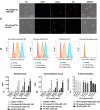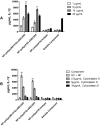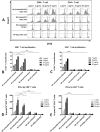In vitro and in vivo evaluation of DC-targeting PLGA nanoparticles encapsulating heparanase CD4+ and CD8+ T-cell epitopes for cancer immunotherapy
- PMID: 35546204
- PMCID: PMC10991543
- DOI: 10.1007/s00262-022-03209-1
In vitro and in vivo evaluation of DC-targeting PLGA nanoparticles encapsulating heparanase CD4+ and CD8+ T-cell epitopes for cancer immunotherapy
Abstract
Heparanase has been identified as a universal tumor-associated antigen, but heparanase epitope peptides are difficult to recognize. Therefore, it is necessary to explore novel strategies to ensure efficient delivery to antigen-presenting cells. Here, we established a novel immunotherapy model targeting antigens to dendritic cell (DC) receptors using a combination of heparanase CD4+ and CD8+ T-cell epitope peptides to achieve an efficient cytotoxic T-cell response, which was associated with strong activation of DCs. First, pegylated poly(lactic-coglycolic acid) (PLGA) nanoparticles (NPs) were used to encapsulate a combined heparanase CD4+ and CD8+ T-cell epitope alone or in combination with Toll-like receptor 3 and 7 ligands as a model antigen to enhance immunogenicity. The ligands were then targeted to DC cell-surface molecules using a DEC-205 antibody. The binding and internalization of these PLGA NPs and the activation of DCs, the T-cell response and the tumor-killing effect were assessed. The results showed that PLGA NPs encapsulating epitope peptides (mHpa399 + mHpa519) could be targeted to and internalized by DCs more efficiently, stimulating higher levels of IL-12 production, T-cell proliferation and IFN-γ production by T cells in vitro. Moreover, vaccination with DEC-205-targeted PLGA NPs encapsulating combined epitope peptides exhibited higher tumor-killing efficacy both in vitro and in vivo. In conclusion, delivery of PLGA NP vaccines targeting DEC-205 based on heparanase CD4+ and CD8+ T-cell epitopes are suitable immunogens for antitumor immunotherapy and have promising potential for clinical applications.
Keywords: Dendritic cells; Heparanase; Nanoparticles; Targeting; Tumor immunotherapy.
© 2022. The Author(s), under exclusive licence to Springer-Verlag GmbH Germany, part of Springer Nature.
Conflict of interest statement
The authors declare that there are no conflict of interest.
Figures






Similar articles
-
Targeting nanoparticles to CD40, DEC-205 or CD11c molecules on dendritic cells for efficient CD8(+) T cell response: a comparative study.J Control Release. 2014 Oct 28;192:209-18. doi: 10.1016/j.jconrel.2014.07.040. Epub 2014 Jul 25. J Control Release. 2014. PMID: 25068703
-
Enhanced stimulation of anti-breast cancer T cells responses by dendritic cells loaded with poly lactic-co-glycolic acid (PLGA) nanoparticle encapsulated tumor antigens.J Exp Clin Cancer Res. 2016 Oct 26;35(1):168. doi: 10.1186/s13046-016-0444-6. J Exp Clin Cancer Res. 2016. PMID: 27782834 Free PMC article.
-
Rational design of nanoparticles towards targeting antigen-presenting cells and improved T cell priming.J Control Release. 2017 Jul 28;258:182-195. doi: 10.1016/j.jconrel.2017.05.014. Epub 2017 May 13. J Control Release. 2017. PMID: 28511928
-
Harnessing Dendritic Cells for Poly (D,L-lactide-co-glycolide) Microspheres (PLGA MS)-Mediated Anti-tumor Therapy.Front Immunol. 2019 Apr 5;10:707. doi: 10.3389/fimmu.2019.00707. eCollection 2019. Front Immunol. 2019. PMID: 31024545 Free PMC article. Review.
-
Targeting dendritic cells with nano-particulate PLGA cancer vaccine formulations.Adv Drug Deliv Rev. 2011 Sep 10;63(10-11):943-55. doi: 10.1016/j.addr.2011.05.021. Epub 2011 Jun 6. Adv Drug Deliv Rev. 2011. PMID: 21679733 Review.
Cited by
-
Cytokine Therapy Combined with Nanomaterials Participates in Cancer Immunotherapy.Pharmaceutics. 2022 Nov 26;14(12):2606. doi: 10.3390/pharmaceutics14122606. Pharmaceutics. 2022. PMID: 36559100 Free PMC article. Review.
-
Cancer biotherapy: review and prospect.Clin Exp Med. 2024 May 27;24(1):114. doi: 10.1007/s10238-024-01376-2. Clin Exp Med. 2024. PMID: 38801637 Free PMC article. Review.
-
PEG-Polymeric Nanocarriers Alleviate the Immunosuppressive Effects of Free 4-Thiazolidinone-Based Chemotherapeutics on T Lymphocyte Function and Cytokine Production.Int J Nanomedicine. 2024 Dec 27;19:14021-14041. doi: 10.2147/IJN.S479137. eCollection 2024. Int J Nanomedicine. 2024. PMID: 39742092 Free PMC article.
-
Nanomaterials in tumor immunotherapy: new strategies and challenges.Mol Cancer. 2023 Jun 13;22(1):94. doi: 10.1186/s12943-023-01797-9. Mol Cancer. 2023. PMID: 37312116 Free PMC article. Review.
-
Cancer Immunotherapy and Delivery System: An Update.Pharmaceutics. 2022 Aug 4;14(8):1630. doi: 10.3390/pharmaceutics14081630. Pharmaceutics. 2022. PMID: 36015256 Free PMC article. Review.
References
MeSH terms
Substances
Grants and funding
LinkOut - more resources
Full Text Sources
Medical
Research Materials
Miscellaneous

